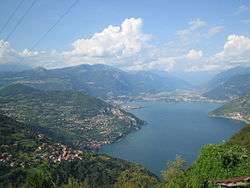Lake Iseo
| Lake Iseo Lago d'Iseo | |
|---|---|
 Lake Iseo | |
 map | |
| Location | Lombardy |
| Coordinates | 45°43′N 10°05′E / 45.717°N 10.083°ECoordinates: 45°43′N 10°05′E / 45.717°N 10.083°E |
| Primary inflows | Oglio |
| Primary outflows | Oglio |
| Catchment area | 1777 km² |
| Basin countries | Italy |
| Max. length | 25 km |
| Surface area | 65.3 km² |
| Average depth | 124 m |
| Max. depth | 251 m |
| Residence time | 8.8 years |
| Surface elevation | 185 m |
| Islands | Monte Isola, Loreto, St. Paul |
| Settlements | see article |
Lake Iseo or Lago d'Iseo [ˈlaːɡo diˈzeːo] or Sebino [seˈbiːno] is the fourth largest lake in Lombardy, Italy, fed by the Oglio river.
It is in the north of the country in the Val Camonica area, near the cities of Brescia and Bergamo. The lake is almost equally divided between the Provinces of Bergamo and Brescia. Northern Italy is renowned for its heavily industrialised towns and in between there are several stunning lakes. Lake Iseo remains one of outstanding natural beauty, with its lush green mountains surrounding the crystal clear lake.
There are several medieval towns around the lake, the largest being Iseo and Sarnico. A notable tourism sector has emerged.
A road has been carved into the side of the mountains that travel to circumvent the entire lake.
In the middle of the lake is Monte Isola (or Montisola). There is easy access via the regular running lake ferries.[1]
The Floating Piers, an art installation by Christo and Jeanne-Claude, was open to the public at Lake Iseo for 16 days in June and July 2016.
Settlements
Around the shore of the lake are some small towns:
| Brescia |
Bergamo |
|---|---|
 A view of the town of Iseo, in the southern part of the lake | |
Two smaller islands, Loreto and St. Paul, are privately owned.
References
- ↑ "Lake Iseo Ferryboat". Navigazione Lago Iseo. Retrieved 14 July 2016.
External links
| Wikimedia Commons has media related to Lago d'Iseo. |